This complex, which means "the sacred sword," was a Buddhist university, a temple, a kind of monastery, and a city. It was built by Jayavarman VII and dedicated to his father. Much has not been restored at this site and, in fact, masonry clutters many of the courtyards, making some exploration hazardous.
The images on these four pages are arranged from the west side of the complex to the east side.Entrance causeway, west side |
 |
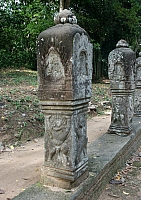
|
The beginning of the causeway has boundary stones with relief figures--lion-headed monsters with human torsos and legs of a garuda. The niches in the tops once held images of Buddha but these were disfigured when Brahmanism returned in the second half of the 13th century. Some of the boundary stones still have their lotus bud caps at the top. |
| |
|
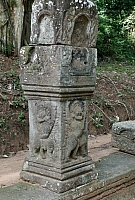
|
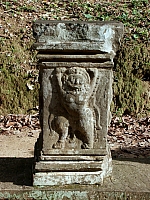
|
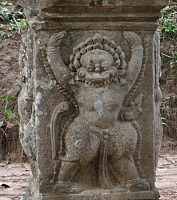
|
| |
|

|
Boundary stone and moatThe causeway broadens as it nears the enclosure wall. Like many of the temples at Angkor, here a moat surrounds the enclosure wall. |
| |
|
The causeway nearer the enclosure wall with naga "bridge"The causeway is lined with stone giants holding nagas--gods on one side and asuras on the other, most of whom have lost their heads. The naga is a multi-headed serpent associated with water, fertility and creation. Five and seven heads are common. Note the incision representing reptilian skin--below right. |
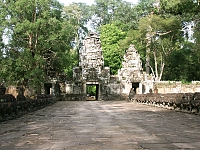
|

|

|
| |
|
Mythological giants on the naga bridge |

|
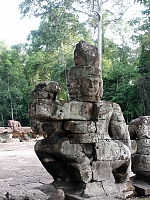
|
| |
|
Entrance, west enclosure wall (fourth enclosure) |
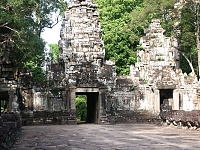
|
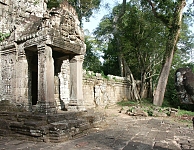 |
The enclosure wall is laterite with decorative sandstone coping. The gopura (or entrance pavilion) includes a central tower with galleries linking two flanking towers. The middle tower has five graduated tiers while the two side towers have three. All three towers are crowned with a budding lotus. These gopuras have false windows, balusters and drawn shades, typical of the Bayon style. |
| |
|
A sandstone relief garudaA garuda is a mythical bird-man, vehicle of Vishnu and enemy of the nagas; this giant figure has clawed hands and feet and holds the tail of a naga in each hand. This is only one of a number, spaced at fifty meter intervals around the Fourth Enclosure. (Our guide told us there were 36; one text says there are 72 in all, while another says 62. I saw only a few of these so obviously couldn't make a count!) |
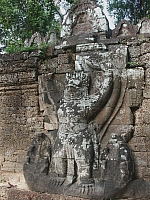
|

|
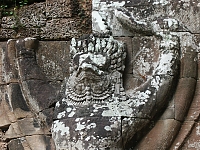
|


 Click here to go to the Cambodia Index.
Click here to go to the Cambodia Index. Click here to return to index of art historical sites.
Click here to return to index of art historical sites.
 Click here to return to index of artists and architects.
Click here to return to index of artists and architects.
 Click here to return to chronological index.
Click here to return to chronological index.
 Click here to see the home page of Bluffton University.
Click here to see the home page of Bluffton University.
